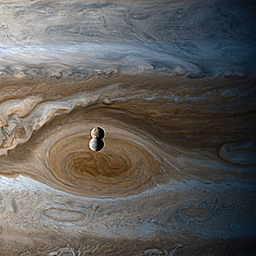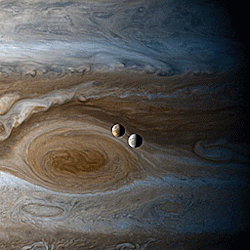Gravity Wells.

Gravity wells.
More Posts from Chaos3612 and Others
⭐ a script for starting a presentation ⭐
“First, I’d like to thank [university / conference / host] for having me, and thank you all for attending my talk. Today I’m presenting work I performed on [general topic] with my collaborators at [university/universities]. To begin, let’s talk about [slide 1 topic].”
Things to bring back in books:
Chapter titles
Actually having a synopsis on the back instead of reviews no one will read


Timelapse of Europa & Io orbiting Jupiter, shot from Cassini during its flyby of Jupiter

“You have the burden of proof backwards when you insist that other people need to prove you wrong. You made the claim, therefore you are responsible for providing evidence to support the claim. No one is obligated to discredit the claim or take it seriously until you have provided evidence.”
The Universe's Brightest Lights Have Some Dark Origins
Did you know some of the brightest sources of light in the sky come from black holes in the centers of galaxies? It sounds a little contradictory, but it’s true! They may not look bright to our eyes, but satellites have spotted oodles of them across the universe.
One of those satellites is our Fermi Gamma-ray Space Telescope. Fermi has found thousands of these kinds of galaxies in the 10 years it’s been operating, and there are many more out there!

Black holes are regions of space that have so much gravity that nothing - not light, not particles, nada - can escape. Most galaxies have supermassive black holes at their centers - these are black holes that are hundreds of thousands to billions of times the mass of our sun - but active galactic nuclei (also called “AGN” for short, or just “active galaxies”) are surrounded by gas and dust that’s constantly falling into the black hole. As the gas and dust fall, they start to spin and form a disk. Because of the friction and other forces at work, the spinning disk starts to heat up.

The disk’s heat gets emitted as light - but not just wavelengths of it that we can see with our eyes. We see light from AGN across the entire electromagnetic spectrum, from the more familiar radio and optical waves through to the more exotic X-rays and gamma rays, which we need special telescopes to spot.

About one in 10 AGN beam out jets of energetic particles, which are traveling almost as fast as light. Scientists are studying these jets to try to understand how black holes - which pull everything in with their huge amounts of gravity - somehow provide the energy needed to propel the particles in these jets.

Many of the ways we tell one type of AGN from another depend on how they’re oriented from our point of view. With radio galaxies, for example, we see the jets from the side as they’re beaming vast amounts of energy into space. Then there’s blazars, which are a type of AGN that have a jet that is pointed almost directly at Earth, which makes the AGN particularly bright.

Our Fermi Gamma-ray Space Telescope has been searching the sky for gamma ray sources for 10 years. More than half (57%) of the sources it has found have been blazars. Gamma rays are useful because they can tell us a lot about how particles accelerate and how they interact with their environment.

So why do we care about AGN? We know that some AGN formed early in the history of the universe. With their enormous power, they almost certainly affected how the universe changed over time. By discovering how AGN work, we can understand better how the universe came to be the way it is now.

Fermi’s helped us learn a lot about the gamma-ray universe over the last 10 years. Learn more about Fermi and how we’re celebrating its accomplishments all year.
Make sure to follow us on Tumblr for your regular dose of space: http://nasa.tumblr.com.
RESONANCES! They affect everything!

Every 11 years, the Sun cycles through from riotous flare and sunspot activity to a quieter period, before ramping up again. It’s almost as regular as clockwork, and for years astronomers have been wondering what causes it. Now, they’ve proposed a new solution.
Even though the Solar System’s planets are much smaller than the Sun, the gravity of some of them is able to influence our star’s magnetic field. This, the researchers assert, is what controls the solar cycle.
Venus, Earth, and Jupiter assert a small gravitational tug on the Sun as they orbit it. The result is comparable to the way the Moon’s gravity influences Earth’s tides, producing a regularly timed ebb and flow.
The team has traced back 1,000 years of solar cycles, between the years 1000 and 2009 CE, comparing that data against the movements of the planets in that time. They found an impressively strong link between the two.
“There is an astonishingly high level of concordance: what we see is complete parallelism with the planets over the course of 90 cycles,” said physicist Frank Stefani of the Helmholtz-Zentrum Dresden-Rossendorf in Germany.
“Everything points to a clocked process.”
What the team found is that the tidal forces are strongest when Earth, Venus, and Jupiter align, and that this alignment occurs every 11.07 years - falling at the same time as the solar minimum.
Continue Reading.
Remember the Women Who Made #Apollo50th Possible
As the world celebrates the 50th anniversary of the historic Moon landing, we remember some of the women whose hard work and ingenuity made it possible. The women featured here represent just a small fraction of the enormous contributions made by women during the Apollo era.
Margaret Hamilton, Computer Programmer

Margaret Hamilton led the team that developed the building blocks of software engineering — a term that she coined herself. Her systems approach to the Apollo software development and insistence on rigorous testing was critical to the success of Apollo. In fact, the Apollo guidance software was so robust that no software bugs were found on any crewed Apollo missions, and it was adapted for use in Skylab, the Space Shuttle and the first digital fly-by-wire systems in aircraft.
In this photo, Hamilton stands next to a stack of Apollo Guidance Computer source code. As she noted, “There was no second chance. We all knew that.”
Katherine Johnson, Aerospace Technologist

As a very young girl, Katherine Johnson loved to count things. She counted everything, from the number of steps she took to get to the road to the number of forks and plates she washed when doing the dishes.
As an adult, Johnson became a “human computer” for the National Advisory Committee for Aeronautics, which in 1958, became NASA. Her calculations were crucial to syncing Apollo’s Lunar Lander with the Moon-orbiting Command and Service Module. “I went to work every day for 33 years happy. Never did I get up and say I don’t want to go to work.“
Judy Sullivan, Biomedical Engineer

This fabulous flip belongs to biomedical engineer Judy Sullivan, who monitored the vital signs of the Apollo 11 astronauts throughout their spaceflight training via small sensors attached to their bodies. On July 16, 1969, she was the only woman in the suit lab as the team helped Neil Armstrong suit up for launch.
Sullivan appeared on the game show “To Tell the Truth,” in which a celebrity panel had to guess which of the female contestants was a biomedical engineer. Her choice to wear a short, ruffled skirt stumped everyone and won her a $500 prize. In this photo, Sullivan monitors a console during a training exercise for the first lunar landing mission.
Billie Robertson, Mathematician

Billie Robertson, pictured here in 1972 running a real-time go-no-go simulation for the Apollo 17 mission, originally intended to become a math teacher. Instead, she worked with the Army Ballistic Missile Agency, which later became rolled into NASA. She created the manual for running computer models that were used to simulate launches for the Apollo, Skylab and Apollo Soyuz Test Project programs.
Robertson regularly visited local schools over the course of her career, empowering young women to pursue careers in STEM and aerospace.
Mary Jackson, Aeronautical Engineer

In 1958, Mary Jackson became NASA’s first African-American female engineer. Her engineering specialty was the extremely complex field of boundary layer effects on aerospace vehicles at supersonic speeds.
In the 1970s, Jackson helped the students at Hampton’s King Street Community center build their own wind tunnel and use it to conduct experiments. “We have to do something like this to get them interested in science,” she said for the local newspaper. “Sometimes they are not aware of the number of black scientists, and don’t even know of the career opportunities until it is too late.”
Ethel Heinecke Bauer, Aerospace Engineer

After watching the launch of Sputnik in October 1957, Ethel Heinecke Bauer changed her major to mathematics. Over her 32 years at NASA, she worked at two different centers in mathematics, aerospace engineering, development and more.
Bauer planned the lunar trajectories for the Apollo program including the ‘free return’ trajectory which allowed for a safe return in the event of a systems failure — a trajectory used on Apollo 13, as well as the first three Apollo flights to the Moon. In the above photo, Bauer works on trajectories with the help of an orbital model.
Follow Women@NASA for more stories like this one, and make sure to follow us on Tumblr for your regular dose of space: http://nasa.tumblr.com.
-
 howilikemusic liked this · 5 years ago
howilikemusic liked this · 5 years ago -
 fabfuta1234 liked this · 5 years ago
fabfuta1234 liked this · 5 years ago -
 chaoticaldynamics reblogged this · 5 years ago
chaoticaldynamics reblogged this · 5 years ago -
 mishivae reblogged this · 5 years ago
mishivae reblogged this · 5 years ago -
 mishivae liked this · 5 years ago
mishivae liked this · 5 years ago -
 chatwiththeclouds liked this · 6 years ago
chatwiththeclouds liked this · 6 years ago -
 languageloveaffair liked this · 6 years ago
languageloveaffair liked this · 6 years ago -
 liapher reblogged this · 6 years ago
liapher reblogged this · 6 years ago -
 ineffabeatlemindpalace liked this · 6 years ago
ineffabeatlemindpalace liked this · 6 years ago -
 lcphotowerx liked this · 6 years ago
lcphotowerx liked this · 6 years ago -
 xombigirl liked this · 6 years ago
xombigirl liked this · 6 years ago -
 cones-of-joshdunshire liked this · 6 years ago
cones-of-joshdunshire liked this · 6 years ago -
 thesoul0fwit reblogged this · 6 years ago
thesoul0fwit reblogged this · 6 years ago -
 pitchsilent liked this · 6 years ago
pitchsilent liked this · 6 years ago -
 proxima-c liked this · 6 years ago
proxima-c liked this · 6 years ago -
 milarca liked this · 6 years ago
milarca liked this · 6 years ago -
 lookingformyperfectsandwich reblogged this · 6 years ago
lookingformyperfectsandwich reblogged this · 6 years ago -
 silvathemagicalgirl reblogged this · 6 years ago
silvathemagicalgirl reblogged this · 6 years ago -
 obiwannaomi reblogged this · 6 years ago
obiwannaomi reblogged this · 6 years ago -
 obiwannaomi liked this · 6 years ago
obiwannaomi liked this · 6 years ago -
 mercury-and-mars reblogged this · 6 years ago
mercury-and-mars reblogged this · 6 years ago -
 golf-echo-romeo-tardis-umqra reblogged this · 6 years ago
golf-echo-romeo-tardis-umqra reblogged this · 6 years ago -
 the-god-of-names liked this · 6 years ago
the-god-of-names liked this · 6 years ago -
 hermanngottlieb liked this · 6 years ago
hermanngottlieb liked this · 6 years ago -
 ozwald-mystery liked this · 6 years ago
ozwald-mystery liked this · 6 years ago -
 zombiequeer liked this · 6 years ago
zombiequeer liked this · 6 years ago -
 jurassicash liked this · 6 years ago
jurassicash liked this · 6 years ago -
 digital-paint reblogged this · 6 years ago
digital-paint reblogged this · 6 years ago -
 digital-paint liked this · 6 years ago
digital-paint liked this · 6 years ago -
 levthankhabla liked this · 6 years ago
levthankhabla liked this · 6 years ago -
 waterbxnder reblogged this · 6 years ago
waterbxnder reblogged this · 6 years ago -
 waterbxnder liked this · 6 years ago
waterbxnder liked this · 6 years ago -
 definitely-not-an-alb reblogged this · 6 years ago
definitely-not-an-alb reblogged this · 6 years ago -
 incurablebookwyrm liked this · 6 years ago
incurablebookwyrm liked this · 6 years ago -
 the-interuniversal-geometer reblogged this · 6 years ago
the-interuniversal-geometer reblogged this · 6 years ago -
 heyimreese reblogged this · 6 years ago
heyimreese reblogged this · 6 years ago -
 uncultureddoubloon reblogged this · 6 years ago
uncultureddoubloon reblogged this · 6 years ago -
 chrrysnstfrz liked this · 6 years ago
chrrysnstfrz liked this · 6 years ago -
 iamonlya liked this · 6 years ago
iamonlya liked this · 6 years ago -
 girlwiththemagic liked this · 6 years ago
girlwiththemagic liked this · 6 years ago -
 rainbow9167 reblogged this · 6 years ago
rainbow9167 reblogged this · 6 years ago -
 tauganra liked this · 6 years ago
tauganra liked this · 6 years ago -
 blameitondisney liked this · 6 years ago
blameitondisney liked this · 6 years ago -
 callisto-ganimedes liked this · 6 years ago
callisto-ganimedes liked this · 6 years ago -
 ilajudica reblogged this · 6 years ago
ilajudica reblogged this · 6 years ago

Small and angry.PhD student. Mathematics. Slow person. Side blog, follow with @talrg.
213 posts





